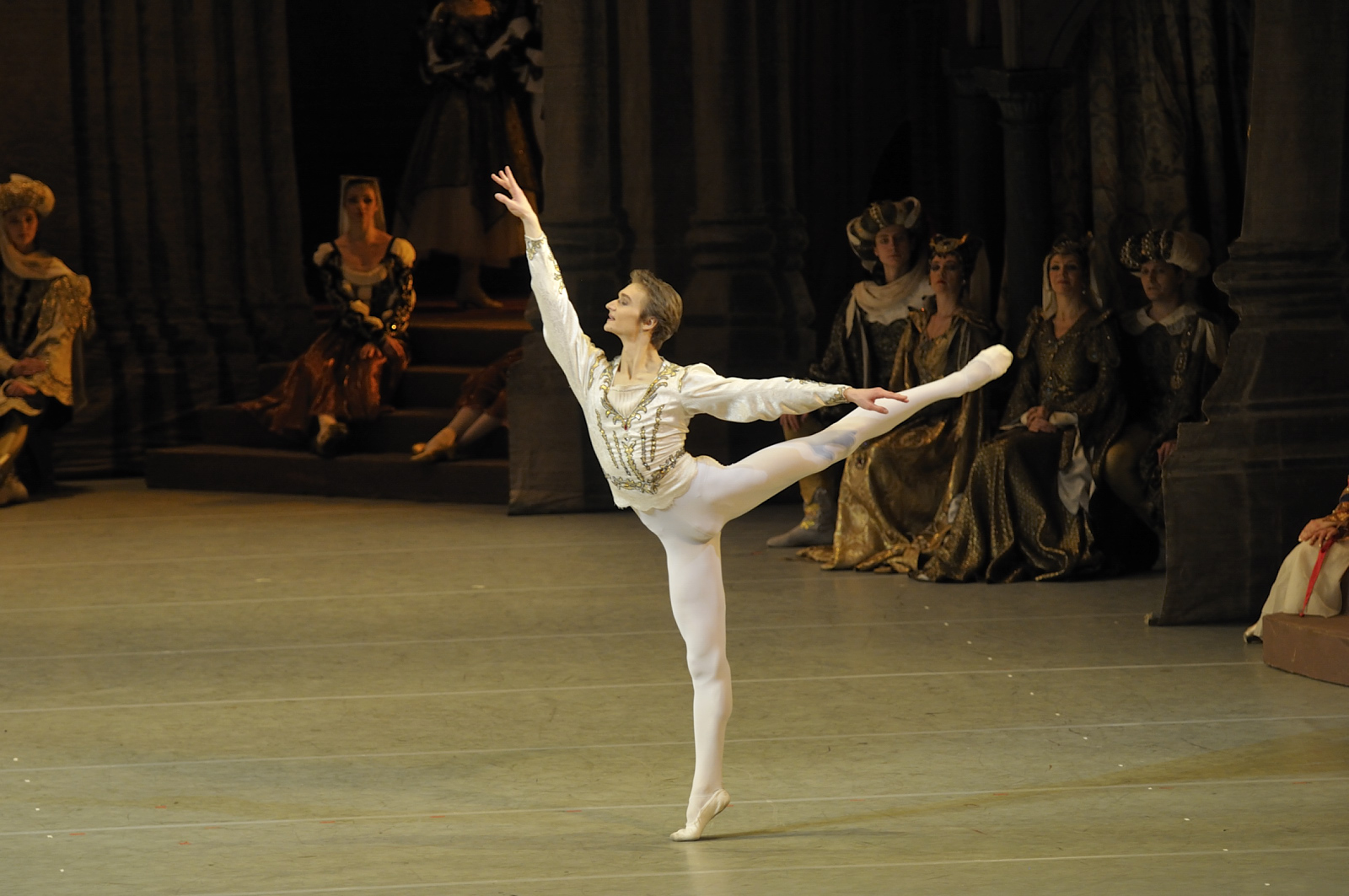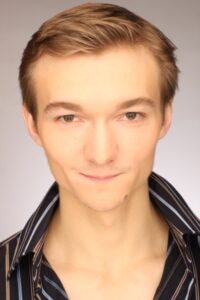 Holding the prestigious position of first soloist with the Mariinsky, Alexander Sergeev is much more than one of the most praised dancers in Russia. He has long been dancing principal roles, and popular opinion suggests he should in fact hold principal status. Sergeev has already created several compelling ballets that have been performed at the Mariinsky’s annual festivals, and he has been pursuing a side business as a concert producer with significant success.
Holding the prestigious position of first soloist with the Mariinsky, Alexander Sergeev is much more than one of the most praised dancers in Russia. He has long been dancing principal roles, and popular opinion suggests he should in fact hold principal status. Sergeev has already created several compelling ballets that have been performed at the Mariinsky’s annual festivals, and he has been pursuing a side business as a concert producer with significant success.
Vaganova Today sat down with him to find out more about his career and aspirations.
* * *
Your parents danced with Theatre Jakobson, did they influence your choice of profession?
Yes, essentially they determined my profession for me (laughs) because I thought I would do something else and pursued taekwon-do seriously for many years. I participated in competitions and seminars, I travelled and trained for it. But at age ten, you know how parents say, “you have to try.” Well… WHY do have to? “You just have to.” And they took me to the [Vaganova] Academy, it was a big audition for admission to the school, and the Academy accepted me conditionally. That means there was a reason why they could have kicked me out during first 6 months, namely I had really trained legs, muscular legs, like the men who do sprinting, but my legs were short.When children audition for the Academy, they always measure height, weight and measure your legs in relation to height and then they give you a ratio. My ratio was low, at 10 years old I had visually “short” legs. But of course this doesn’t mean anything at all, because that little boy at age 10 who they deem “short”, he will be 40 cm higher in a few years. So they took me conditionally, and my parents signed a special waiver that they would not have any claims against Academy if they dismissed me after half a year. But they didn’t. So I continued.
Sergeev as Siegfried in Swan Lake. Photo: Natalia Razina
Did you enjoy the classes?
No. It was late for me to restructure my physiology. My physique was already built around another professional activity, which was sports. Children in sports have to be built completely differently than in ballet. It was extremely difficult for me the first 2 or 3 years at the Academy. it was like they were breaking me, you know, when they try to remake you, recreate you.
The general education classes — Russian language, chemistry, biology, math etc. –were also difficult. If you can imagine, a child leaves their first primary school where you’re all “drawing berries and flowers”, and is thrown into middle school with really demanding requirements, and in addition to that there is a complete physiological reconstruction. It was really difficult. I cried and was upset. But in 3 years I adapted.
When did you feel serious about it as a profession?
After about 3 years at the Academy, I felt it was starting to work for me. Of course I gained a great deal of satisfaction from participating in performances at the Mariinsky and Mikhailovsky Theatres. In the 2nd class [year] we had already gone on tour to New York, and twice to Japan with the Mikhailovsky. Of course that captivates you, you can’t refuse it after you’ve tasted it. Then you feel yeah, ballet isn’t so bad.
After graduation from the Academy, was the Mariinsky your first choice or did you consider Jakobson?
No, I thought either the Mariinsky or abroad. If the Mariinsky hadn’t taken me I would have tried to audition elsewhere, maybe Berlin, Amsterdam, Dresden. But they took me and that question disappeared.
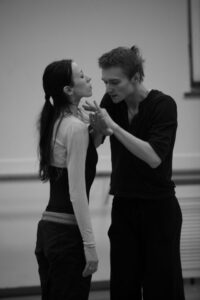 What were your impressions during your first years in the Mariinsky?
What were your impressions during your first years in the Mariinsky?
I had a sea of impressions. I remember it was a huge workload. They give you something to try out, a tiny solo part, but you work in the corps de ballet and also dance in operas and sometimes as a supernumerary, and all of that simultaneously. You might have a performance working in the corps in the evening, and between morning and evening you have time when you might rehearse something they gave you. So you spend 12 hours in the theatre and are constantly working and rehearsing. It was a difficult ordeal. But it turned out that, for example the third month of work, I danced Espada in Don Quixote, which was completely unexpected. The troupe went on tour, everyone at home got sick, and there no one to dance it. The directorship already knew that I was good with all character and folk dances. So after 2 rehearsals, I danced it. In my fourth month in the theatre, I performed in Forsythe’s In the Middle Somewhat Elevated.
In my 5th month of work in the theatre, I danced the “Sanguine” section of Balanchine’s Four Temperaments with Ekaterina Osmolkina. Both this ballet and In the Middle were shown at the Golden Mask awards, and the Forsythe programme won the award.
In the 6th month, I premiered in David Dawson’s Reverence, which featured 6 dancers and all were stars except for me. I was nominated for a Golden Mask award for this work. So it was super cool. I felt that all my dreams had come true immediately.
You dance roles like Espada, Mercutio, and various princes wonderfully, but you’ve said in the past that you didn’t see yourself dancing the classics?
Classical roles were difficult for me, and even now they still are. But when I first joined the theatre, I felt I needed time to strengthen myself and dance the classics with a certain degree of quality. Gradually that happened at the end of the 2nd, 3rd and 4th seasons, when I danced Giselle and Fountain of Bakhchisarai.
Was modern of more interest at that point?
When I studied I really wanted to dance modern choreography, but I thought in terms of neoclassical, since at the Vaganova Academy we studied classical repertoire and methodology, so there was a strong base for neoclassical dance, but I didn’t think it would happen so fast.
In Le Jeune Homme et La Mort. Photo: Marc Olich.
Did you ask to dance any roles at the Mariinsky?
I asked twice in the course of 17 seasons. The first role I asked for was Romeo, as I had danced Mercutio for many years, as of my 3rd season onward, and I really wanted Romeo. They gave it to me and I continue to dance both roles. The second time was Vizier in The Legend of Love, that was a role of my dreams, they gave it to me, and I still dance it.
How do you prepare for classical roles? Do you look to literature?
Yes, I do read because it seems to me all of our classical roles– Romeo to a lesser degree,but all of the princes (Desiré, Siegfried, Albrecht)– they are not all fully characterized in their respective productions. They’re all a bit similar to each other and you want them to be different because they’re different characters, so I try to dig deep in that respect. Maybe not in terms of literature, but the libretto or the literary sources. In many productions there’s not just one source, a fairy tale or book or legend, but various sources. So it helps to create the role more precisely and veer away from having it remain mundane. One good example, in the first act of Swan Lake, Tchaikovsky wrote a very slow variation into the score for Siegfried, and Konstantin Sergeyev set the choreography. They never require us to dance it, you have a choice to do so or not, they say if you don’t want to, you don’t have to. But I always dance it, because I feel it’s absolutely necessary since Siegfried’s image is not fully developed.
Who was your pedagogue at the Academy and who do you work with now?
I graduated under Gennady Seliutsky, but for the past 16 years in the theatre I have worked with Igor Petrov, who is also a student of Seliutsky, but he graduated in 1981. When I joined the theatre, Makhar Vasiev immediately assigned me to Petrov. We work on all of my classical roles together: Swan Lake, Giselle, Romeo, Nutcracker, Fountain of Bakhchisarai. I dance a lot of Ratmansky works, and his ballets are all rehearsed by Maxim Khrebtov. I also dance a lot of Balanchine, and Yuri Fateyev (head of the ballet troupe) rehearses all of those. For character roles, like the Toreador in Don Q, I rehearse with Dmitry Korneyev. So there are many rehearsal coaches.
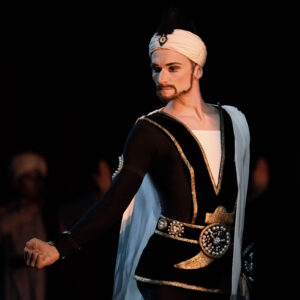
What is the role of a pedagogue in the dancer’s career and life?
Its hard to say because for me, my pedagogue is only a repetiteur, or rehearsal coach. I never allowed the pedagogue to be closer than work. There are pedagogues who tell the dancer when to go to sleep, when to get up, when to eat, what to eat, which girl to date or not to date. That’s a case of too much participation. I never had that in school and or in the theatre. For me, the pedagogue is only in the studio — we go, work productively, and that’s it.
For those not familiar with the tradition, then, why do you need pedagogue?
You absolutely need a professional eye and an experienced individual who can tell you how to correct technical complexities and how to create a character in a performance, what looks better on you, and so forth.
For example, I absolutely cannot work without a repetiteur. I need the second eye. If I go in the studio and I don’t have a repetiteur, I will not rehearse, I will leave. I need someone to be there.
As a choreographer you already presented your ballets twice at the Mariinsky Festival and a third work, Pioneer Suite, was set for this year’s festival (March 2020). Had your desire to choreography existed for a while?
I can’t say that I wanted to choreograph for a long time, no, but I thought about it for a long time. About 12 years ago, when Aleksey Ratmansky set Pierrot Lunaire he told me –and this was in 2008– “Sasha, you have to try to set choreography because you hear the music really well.” And I said, “Oh no, no it’s not for me, I want to be a conductor.” I honestly wanted to be a conductor at that point. But evidently something matured in me, and I arrived at this point. I’m not sure that it will remain, that I’ll continue to enjoy it, but right now I want to try to choreograph.
You set the ballet Farfor [Porcelain] to the music of Glinka for this year’s Workshop, which was nominated as “Best New Work” in Dance Europe magazine and also included on the long list for Russia’s Golden Mask awards. What was the idea for the ballet, and where is the theme from?
The idea always comes from the music first. I specially took three totally different works by Glinka, I mean the atmosphere, character of the music: Kamarinskaya, Aragonskaya Khota, and Waltz Fantasy. The task was, using choreographic methods and subtext, to show the difference in mood and nature of the three 3 pieces of his music and so that it was visible, but not through character dances but through classical dances and expressive bodily movement. For that of course I had to remove any individuality from the costumes. So all the dancers were in the same costumes, but the mood and character of each section changes with the music, and some specific movements we seem to “photograph” so that the viewer says “Oh, I recognize that” at various points.
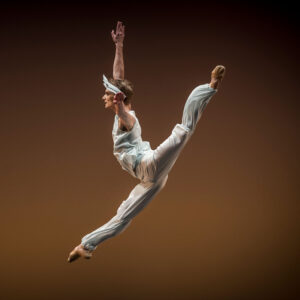 Why did you choose the name “Farfor” for the ballet?
Why did you choose the name “Farfor” for the ballet?
First, because dancers are our porcelain in the theatre, they are our jewels. And secondly because there is a very interesting idea always haunted Glinka, even after his death. His remains were brought from Germany to Russia in a box on which the word “porcelain” was written so that they would not be shaken. And after the premiere of the opera, A Life for the Tsar, a group of poets including Alexander Pushkin created a canon that mentions “Our Glinka”, in which Glinka is now not only the composer, but porcelain — our pride and fortune.
COVID-19 has interrupted the world ballet stage. How did you live through the quarantine?
I didn’t believe we would be without work that long. I thought 2 weeks would pass and we would go back to work. When they told us it would last at least until the summer, realistically I didn’t want to believe it and wasn’t sure how to survive. But it turned out to be a great time, I remember it as wonderful time that our family spent together. My wife Dasha [ed.: Daria Pavlenko, former prima ballerina of the Mariinsky Theatre] and I were with our children, we all had the same schedule, we all slept and ate at the same time, we took walks outside, even when we could not [officially due to the quarantine], we found places we could go walk. It was amazing weather and I don’t know what it was connected with but I have the impression it was constant sunshine. People said there were unrealistic amount of sunny days during that period. I personally had impression of constantly sunny weather. So I am grateful for that period because it forced us to stop, take a break, and reexamine what in fact is really important in life and what is not important. We probably all needed to take that time out.
How did you remain in shape?
We worked out at home daily but we didn’t do class, because we can’t jump or turn, and holding the bookcase to do a barre isn’t quite right. In sum, it was clear that the physical load would not be enough for us [without class/rehearsal in the theatre], so for approximately 1 hour per day we devoted to serious training. We chose various programs – either total workout or interval training or cardio, alternating, ab and muscle work. We tried to do it so that within 40 minutes we would be tired out. And that’s how we stayed in shape, although when they called us back to the theatre, it was already clear some things had fallen out of shape, for example, your feet and ligaments in the lower leg, calf and feet, some things that you can only train in ballet.
You were one of those who caught Covid at the Mariinsky, how did you recover?
We had an outbreak and within the span of 4 days, almost 60 people got sick. I was one of them. It was in August, when we were already back at work, but everyone had different degrees of severity. I had a rather mild form: 3 days of fever, my throat hurt, and 2 weeks of utter fatigue and no strength. But then I was fine.
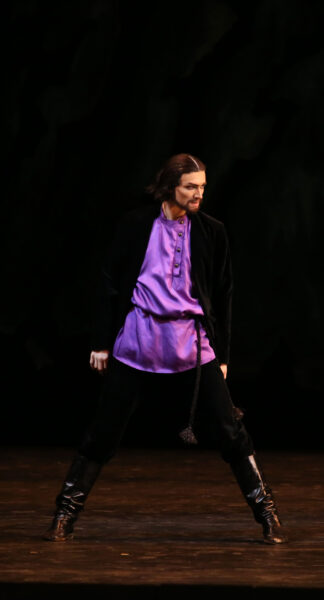 What sort of measures did the theatre take to help prevent the spread?
What sort of measures did the theatre take to help prevent the spread?
From start of September, the way the ballet troupe is working is that it is divided into 2 parts. They create the schedule so that those two groups do not interact with each other.One group dances one set of productions and the other dances another set. The soloists work with everyone, but rehearse separately. I think this system works. Even if someone gets sick — because someone is getting sick every week, from one to three people. But it allows them to localise the focal point of the outbreak so it doesn’t spread to 60 people again. It is also important we are not taking class with 50 people anymore, but 10-12 per studio, and our studios are large. Also now everyone in the company is tested for Covid every 2 weeks.
You recently created Pioneer Suite for the Mariinsky Festival this year, and it will be shown on national television in November. How did it come about?
A year ago I wanted to set a classical pas de deux with conditional structure: entrée, adagio, 2 variations and a coda. So I started to search for music and landed on a rare piece of music by Shostakovich, the theatre didn’t even have the score, they had to obtain it. It’s the music that from the film, Prikluchenie Korzinkinoi [Korzinkina’s Adventures]. And this returns to the question of the music, the music gave me the impression that they are pioneers and not any other character. Initially I called it Pioneer Pas de Deux but decided not to change the structure of Shostakovich’s Suite, as it was a suite and not a duet, there are 6 numbers in it. So I preserved that structure, and since it was not standard in terms of a duet, I called it a Suite. It should have been performed at the Festival closing gala in March as Maria Khoreva and Vladimir Shklyarov had rehearsed it and the costumes were ready. But 3 days prior to the gala, we closed due to Covid. It will be on national Russian television as part of the competition that will air for 7 weeks starting in November.
You have a lot of outside projects going on right now in addition to just performing. There is one with the Russian Museum of Saint Petersburg?
Yes, the Russian Museum has joint project with the Mariinsky that now it in the process of filming. The idea is that dancers and singers perform inside the Stroganoff Palace, Marble Palace, and the Mikhailovsky Palace. One fragment will be danced from my ballet, At the Wrong Time, from the first Mariinsky Festival to music by Villa Lobos. And two small fragments of a new work will be danced by Victor Caixeta and May Nagahisa, and Roman Malyshev and Svetlana Savelieva which I created especially for the Mikhailovsky Palace and film.
In 2015 you received a diploma as a Producer from the Academy?
Actually I worked professionally as a producer quite a few times prior to that. As part of the JokerLab Production company, we created Dances of Love which appeared 2 twice in Moscow and once in Saint Petersburg. Now we’re working on big project, an evening of ballet set to music by Leonid Desyatnikov, which is now set for April in Ekaterinburg featuring 4 choreographers, Slava Samodurov, Andrey Kaydanovsky, Anton Pimonov and Maxim Petrov.
Is social media beneficial or not?
Right now we live in such a time that you can’t go anywhere without social media. My wife and I have never professionally managed social media pages because it really takes a lot of time out of life. It is probably necessary, but so far we haven’t adapted to it and are not ready to devote enough time to it at the expense of time with family, for example.
During lockdown, you and your wife aired an Instagram program where you cooked a meal in your kitchen for the viewers, and it was very popular. Will you do more of these?
Concerning food I don’t know if there will be more. People liked it, so maybe if there is another lockdown then we will.
Do you two cook together often?
Mainly Dasha cooks on her own, she has done so since her childhood in the dorms, and she is a great cook. But if she goes on tour, and last year she did so a lot to Wuppertal, then I am left alone with 2 children and I have to prepare food every day. Right now she is home and she does most of it. But there are some signature dishes that I do, the sauce for spaghetti bolognese is mine. Or, for example, beef in beer, or chakhokhbili (a Georgian chicken sauté), then if that’s the dish, I make it.
Although it is still far off for you, do you have any plans for after the stage?
Right now, I have only one desire which is, while I have my health and the resources in my body, to dance as much as possible. When I understand that it’s a nightmare and I can’t continue any longer then I will shift to something else. But while I have the chance to use myself in dancing, then I will do it.
People often ask if I want to be pedagogue. I always said no. Now I think, why not? I think I’d even like to go to the Academy go to teach possibly at some point, only not now. I don’t know how it will go with choreography.
You have two daughters. Do they dance?
The younger one, now 4 years old may still dance at some point. Our eldest daughter, Yaroslava is now 12, and she did not want to and we did not want her to because we saw her traits, and the proclivity, not just physically but morally, was not there. There is some sort of type of special character one needs in order to pursue ballet. Maybe fanaticism has to exist in a person and our older daughter is very ….how can I explain this… she is very stable, sensible and she weighs what is good and bad. She says she wants to be a psychologist. I think she could be a good one, because she looks at things from the outside very coolly. Stably. For ballet that doesn’t really work.
How do you manage to juggle work and family?
Dasha, my wife, as of June this year joined the Jakobson Ballet Theatre as a pedagogue and rehearsal coach, and is also studying at the Conservatory, so both of our schedules are really full. But we try to find time for everything and we plan a lot.
I perform 5 to 7 times per month, so I don’t have nightly performances. If I have a performance and she’s not there, I call my parents, they come help and they leave once I’m home. If I do not have a performance, then I manage the daytime schedule so that I can pick up Yaroslava and Miroslava and take them to the pool or drawing.
What inspires you?
My family and children. Yes, that’s for sure.
Photo credits: Portrait photo by Oleg Zotov. Black-and-white rehearsal photo of Le Parc with Viktoria Tereshkina in the studio by Vladimir Lupovsky. In The Legend of Love, photo by Irina Tuminene. In The Stone Flower by Sila Avvakum. Airborne jété, in The Talisman, photo by Carlos Quezada.
